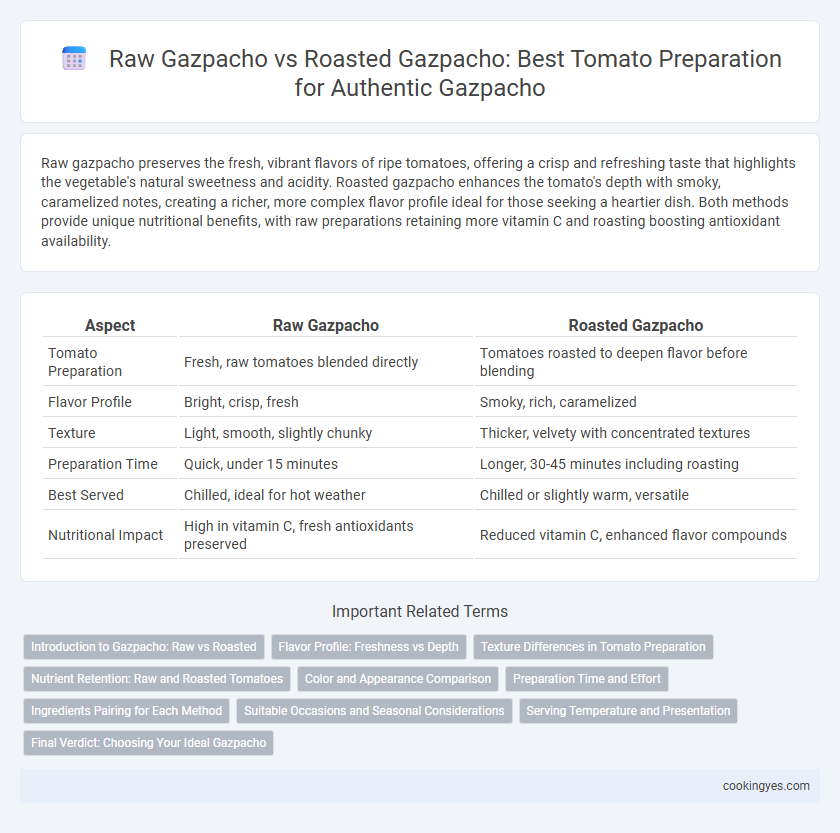Raw gazpacho preserves the fresh, vibrant flavors of ripe tomatoes, offering a crisp and refreshing taste that highlights the vegetable's natural sweetness and acidity. Roasted gazpacho enhances the tomato's depth with smoky, caramelized notes, creating a richer, more complex flavor profile ideal for those seeking a heartier dish. Both methods provide unique nutritional benefits, with raw preparations retaining more vitamin C and roasting boosting antioxidant availability.
Table of Comparison
| Aspect | Raw Gazpacho | Roasted Gazpacho |
|---|---|---|
| Tomato Preparation | Fresh, raw tomatoes blended directly | Tomatoes roasted to deepen flavor before blending |
| Flavor Profile | Bright, crisp, fresh | Smoky, rich, caramelized |
| Texture | Light, smooth, slightly chunky | Thicker, velvety with concentrated textures |
| Preparation Time | Quick, under 15 minutes | Longer, 30-45 minutes including roasting |
| Best Served | Chilled, ideal for hot weather | Chilled or slightly warm, versatile |
| Nutritional Impact | High in vitamin C, fresh antioxidants preserved | Reduced vitamin C, enhanced flavor compounds |
Introduction to Gazpacho: Raw vs Roasted
Raw gazpacho preserves the bright, fresh acidity of ripe tomatoes, delivering a crisp, vibrant flavor profile ideal for hot summer days. Roasted gazpacho enhances tomato depth through caramelization, adding smoky, rich undertones and a thicker texture. Choosing between raw and roasted tomato preparation influences the overall taste, texture, and complexity of this classic Spanish cold soup.
Flavor Profile: Freshness vs Depth
Raw gazpacho highlights the vibrant freshness of tomatoes, offering bright, crisp, and slightly tangy flavors that emphasize the natural juiciness and acidity of fresh produce. Roasted gazpacho, on the other hand, develops a deeper, richer flavor profile, with caramelized tomato notes and smoky undertones that add complexity and warmth. The choice between raw and roasted tomatoes fundamentally alters the soup's character, balancing freshness against savory depth.
Texture Differences in Tomato Preparation
Raw gazpacho features tomatoes blended into a fresh, crisp texture that highlights their natural juiciness and firmness, creating a vibrant, refreshing soup. Roasted gazpacho, by contrast, transforms tomatoes through roasting, softening their flesh and enhancing a velvety, smoky texture that deepens the flavor profile. The texture difference between raw and roasted tomato preparations significantly influences mouthfeel and overall sensory experience in each gazpacho variation.
Nutrient Retention: Raw and Roasted Tomatoes
Raw gazpacho preserves higher levels of vitamin C and antioxidants like lycopene in tomatoes, as minimal heat exposure prevents nutrient degradation. Roasted gazpacho enhances the bioavailability of lycopene and carotenoids due to heat-induced cell wall breakdown but may reduce heat-sensitive vitamins such as vitamin C. Choosing between raw and roasted tomatoes depends on whether preserving vitamin C or increasing lycopene absorption is prioritized in nutrient retention.
Color and Appearance Comparison
Raw gazpacho offers a vibrant, bright red color due to the fresh, uncooked tomatoes, enhancing visual appeal with its lively and crisp appearance. Roasted gazpacho presents a deeper, richer hue with slightly caramelized tones, giving the soup a warm, rustic look that hints at its smoky flavor profile. The color intensity in roasted gazpacho suggests concentrated tomato flavors, while raw gazpacho maintains a fresher, lighter aesthetic.
Preparation Time and Effort
Raw gazpacho requires a shorter preparation time since tomatoes are simply blended with other fresh ingredients, preserving their natural flavor and texture. Roasted gazpacho demands more effort and time as tomatoes must be roasted beforehand, enhancing depth and sweetness but adding cooking and cooling steps. Choosing between raw and roasted depends on whether efficiency or complexity in flavor is prioritized.
Ingredients Pairing for Each Method
Raw gazpacho highlights the fresh, vibrant flavors of ripe tomatoes combined with cucumber, green bell peppers, and fresh herbs like basil or parsley to maintain a crisp, refreshing profile. Roasted gazpacho transforms the tomato's sweetness and umami by pairing roasted tomatoes with charred garlic, smoky red peppers, and rich ingredients such as olive oil and smoked paprika to enhance depth and complexity. Both methods leverage complementary ingredients to balance acidity and enhance tomato flavor, with raw preparation emphasizing brightness and roasted showcasing warmth.
Suitable Occasions and Seasonal Considerations
Raw gazpacho offers a refreshing, crisp flavor ideal for hot summer days and outdoor gatherings, providing a light and hydrating option rich in fresh, uncooked tomatoes. Roasted gazpacho, with its deeper, smoky tomato flavor, suits cooler months and cozy indoor meals, delivering a warm, comforting twist that enhances roasted tomato sweetness and complexity. Seasonal considerations prioritize raw gazpacho for peak tomato freshness in mid to late summer, while roasted gazpacho leverages late-season or slightly underripe tomatoes to intensify their flavor through roasting.
Serving Temperature and Presentation
Raw gazpacho is traditionally served chilled, emphasizing its refreshing and crisp tomato flavor, often presented with vibrant garnishes like diced cucumbers, peppers, and fresh herbs to highlight its fresh ingredients. Roasted gazpacho, served slightly warmer or at room temperature, offers a richer, smoky tomato profile, typically presented with roasted vegetable toppings or a drizzle of smoky olive oil to enhance its depth and warmth. Serving temperature significantly influences the sensory experience, with raw gazpacho accentuating freshness and roasted gazpacho emphasizing complexity and comfort.
Final Verdict: Choosing Your Ideal Gazpacho
Raw gazpacho preserves the vibrant acidity and fresh flavor of ripe tomatoes, ideal for a light, refreshing cold soup. Roasted gazpacho offers a deeper, smoky sweetness by caramelizing tomatoes, enhancing complexity and warmth. Selecting between raw and roasted tomato preparation depends on whether you prefer a crisp, bright gazpacho or a rich, robust taste profile.
Raw Gazpacho vs Roasted Gazpacho for tomato preparation Infographic

 cookingyes.com
cookingyes.com